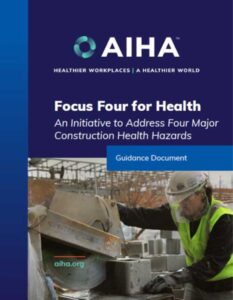By Barb Epstien, MPH, CIH
Industrial Hygienist

Why is there much lower awareness of construction health hazards? Well, workplace health hazards are much less obvious; they’re harder to “see.” When an occupational injury occurs, it’s usually immediate, which is often not the case with occupational illnesses. Many are caused by chronic, long-term exposures, so the link to work is less obvious. And as a result, fewer guidance materials and training resources have been developed, and regulatory activity for construction health hazards has also been much lower. The inadvertent message sent and received is that health hazards are not a priority.
But they should be. Occupational illnesses are a lot more common that you might think, and can have severe, disabling effects that can hijack a construction worker’s career and affect them long into retirement. So, this is where Focus Four for Health comes in. Written by a team of industrial hygienists working in construction who are members of the AIHA Construction Committee, this new guidance booklet was launched in 2019 as a companion piece to the original Focus Four.
Our Focus Four for Health topics are:
- Manual material handling;
- Noise;
- Air Contaminants; and
- High temperatures
For each topic, it discusses the impact of the hazard, what trades are most affected, and uses job hazard analyses (JHAs) and other control strategies to show how to “see” the risk factors. It also suggests some practical steps to target tasks with the highest exposure risk and offers methods for preventing and controlling exposures. This one-stop resource is worth your time, so check it out. And remember that your AGC Oregon-Columbia Chapter industrial hygienists and safety management consultants are available to help you identify and evaluate potential health hazard risks, and to guide you on solutions.